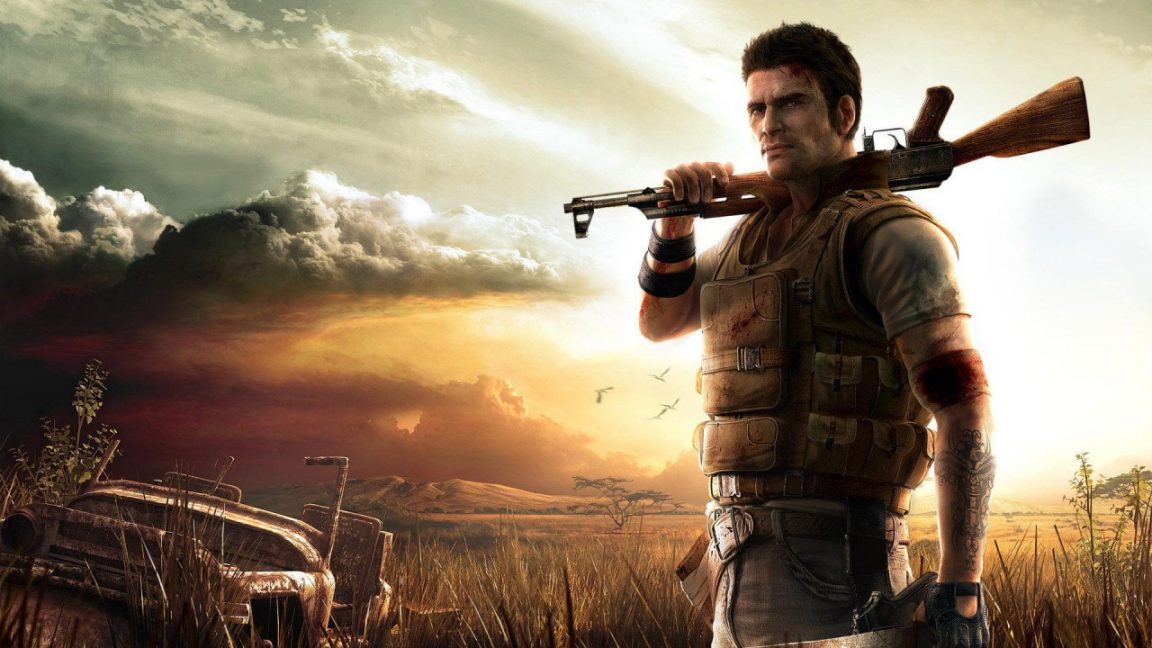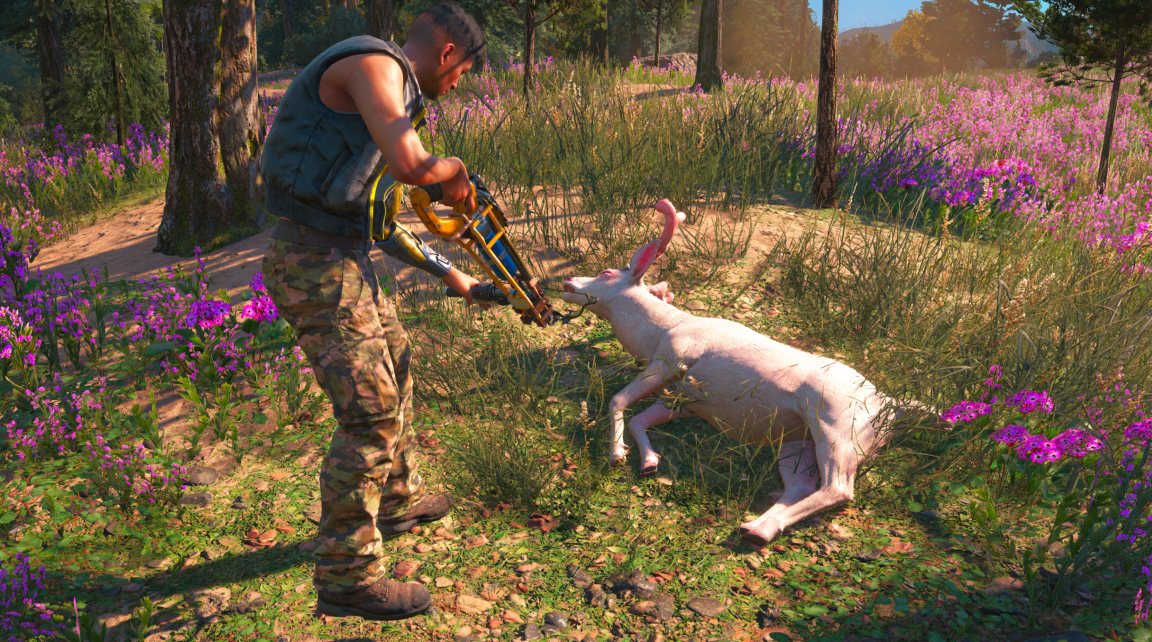“Hello chicken,” says Slogoman, within the vibrant, trebly tone that distinguishes an expert YouTuber. “Stay exactly there.”
He breaks right into a dash, then an influence slide. The second he connects with the rooster it takes off with a comedy ‘bukhaw’, hovering into the aspect of a close-by planter with a clunk, earlier than falling immobile to the bottom. “Woah-ho-ho,” says the YouTuber. “He went flying!” A second later a canine wanders over to smell on the susceptible poultry, so Slogoman ruffles the hair on its head.
The clip from Far Cry New Dawn, reposted on Ubisoft UK’s Twitter account and over in 37 seconds, captures the tonal incongruity of the sequence’ strategy to animals. It’s not as if it’s the primary time digital chickens have been booted round within the identify of bodily comedy – if something, Slogoman ought to be paying royalties to the makers of Fable. But it’s a stark and unusual approach to promote a brand new Far Cry game, particularly when you think about the place the sequence got here from.
Check out the total video on Slogoman’s YouTube channel! 🐔 #FarCryNewDawn
>> https://t.co/qClJhdHBe3
*No chickens had been harmed within the making of this video. pic.twitter.com/Ol8cMWjFq8— Ubisoft UK (@Ubisoft_UK) January 31, 2019
At one level throughout the creation of Far Cry 2, the plan was that you’d be capable of pet the zebras. It was a charmingly mild, if ludicrous, steered answer to an issue to builders had been having with their wildlife. A crew led by Clint Hocking at Ubisoft Montreal had fully reimagined Crytek’s stealth-shooter as an African savanna-based simulation – one wherein the open world was simply as convincing whenever you parked up the jeep to look at the solar set behind a Baobab tree as whenever you fired shotgun slugs into the aspect of an enemy compound.
The thought was that the serene mundanity current in Far Cry 2’s map would heighten the messy, frantic horror of the shootouts, and for some time the dev crew sought to carry that element and depth to the gazelles and buffaloes that roamed the map. That is, till they began playtesting.
“A lot of testers were just running around shooting animals and laughing about it,” Hocking informed Idle Thumbs in 2013. “That made us uncomfortable, and we came up with a lot of different plans to fix it.”
The zebra-petting was a part of an try and make constructive interplay with animals potential, and so steer participant behaviour in that course. But down that path had been all types of knock-on design questions that Ubisoft didn’t have the solutions to, and so in the end Hocking determined to place his design philosophy into reverse: the animals would decide out of the simulation. In the ultimate game, gazelles drop lifeless with a single shot out of your rifle, or on the slightest contact of your bumper. And they actually drop, too: not with a lavish dying animation, however slumping merely and unsatisfyingly to the bottom.

“You can’t machine gun it around the plains, and make its legs flop or float in the water and be ridiculous,” stated Hocking. “It just becomes not part of the simulation anymore. And guess what, it’s really boring.”
It’s the identical precept mother and father have lived by for generations, telling their youngsters to not give bullies the response they so desperately crave. After the change was made, gamers who shot at Far Cry 2’s wildlife obtained nothing out of it, and by no means bothered doing so once more.
Perhaps that may have remained the case because the Far Cry sequence handed into the arms of different groups at Ubisoft – if not for the truth that Far Cry 2 had a blended response. Although admired by a cult following, the game was intentionally irritating in different features, like its capturing – throughout which weapons would sometimes jam and go away you susceptible. That pervasive sense of discomfort proved divisive, and when Ubisoft returned to the sequence for Far Cry 3, it filed off a few of the edges, pulling in classes discovered from different open world games on the writer’s slate.
Far Cry 2 had lacked express, RPG-like development methods to maintain gamers hooked, and so Far Cry Three needed to have these. It’s notable that Assassin’s Creed 3, developed by the identical studio on the identical time, had tailored stealth methods into searching mechanics. Hunting turned an important a part of your development in Far Cry Three too, eradicating restrictions in your weapon rely as you skinned goats, turning them into holsters.

Ubisoft’s new strategy was proven to be the shrewd one – Far Cry Three was vastly common and revitalised the sequence, permitting it to turn out to be the multi-team franchise it’s at this time. But it’s onerous to think about a game in additional direct opposition to its predecessor’s coverage on animals.
Until Far Cry 4, that’s. By then, Ubisoft was properly leaning into the emergent chaos of its open worlds, producing as many panicked moments of unscripted convergence because it may. To that finish, the AI of its wildlife turned hyper-aggressive, such that it turned inconceivable to take a fast hike throughout Kyrat with out feeling claws in your cranium and enamel gnawing at your legs. Rather than an ambient sideshow to the motion, Far Cry animals had turn out to be an ever-present risk, and gunning down eagles and honey badgers a part of its central motion.
In Far Cry 5 the animals had been bosses – massive cats and grizzlies drugged up on Bliss, put down within the identify of the local people. At the identical time, the sequence launched Fangs for Hire: cute companions like Boomer the canine and Cheeseburger the bear. The tonal mismatch may hardly have been extra pronounced than when Peaches the mountain lion came across one in every of her personal type, and within the scuffle you forgot which an identical creature you had been purported to be capturing at.
This shouldn’t be an remoted downside: in recent times, satisfying mechanics have typically overridden tonal considerations in Ubisoft’s largest games. I wouldn’t be the primary particular person to level out that murdering determined civilians looting espresso retailers in The Division’s New York could possibly be nauseating, or that Ghost Recon Wildlands trampled over Bolivia with the attitude of an invader, venerating the tradition of particular forces troopers over that of an actual South American nation. But there’s a specific unhappiness to the story of Far Cry, a sequence price celebrating for its reinvention, however which misplaced its quiet respect for wildlife alongside the best way.
Source


